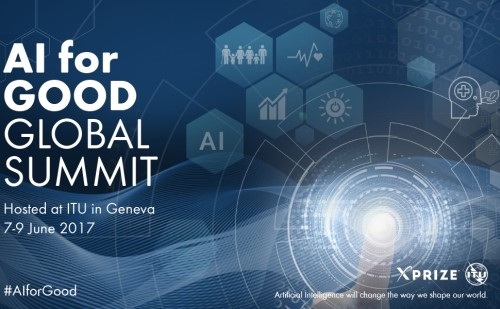
Opening Remarks at the Artificial Intelligence for Good Global Summit文章源自英文巴士-https://www.en84.com/3119.html
“人工智能惠及人类全球峰会”开幕致辞文章源自英文巴士-https://www.en84.com/3119.html
文章源自英文巴士-https://www.en84.com/3119.html
Dr. Margaret Chan, Director-General of the World Health Organization文章源自英文巴士-https://www.en84.com/3119.html
世界卫生组织总干事 陈冯富珍博士文章源自英文巴士-https://www.en84.com/3119.html
文章源自英文巴士-https://www.en84.com/3119.html
Geneva, Switzerland文章源自英文巴士-https://www.en84.com/3119.html
瑞士 日内瓦文章源自英文巴士-https://www.en84.com/3119.html
文章源自英文巴士-https://www.en84.com/3119.html
7 June 2017文章源自英文巴士-https://www.en84.com/3119.html
2017年6月7日
Fellow UN agencies, experts in artificial intelligence, representatives of industry, ladies and gentlemen,
联合国机构的同事们、人工智能领域的专家们、业界代表们、女士们、先生们,
I welcome this opportunity to learn from the vast amount of technical expertise assembled in this room.
今天这里汇集了大量技术专长,我很高兴能有此机会从中学习。
Market analysts predict that intelligent machines, programmed to think and reason like the human mind, will revolutionize health care in the very near future. In fact, proponents of the transformative power of artificial intelligence usually give two examples: self-driving cars and the delivery of health care.
市场分析师们预言,在不久的将来,经过编程能够像人脑一样思考和推理的智能机器将在卫生保健领域引起突破性变革。确切说,人工智能变革力量的支持者们常常会举两个例子:自驾车和卫生保健服务的提供。
This year’s influential Internet Trends Report, released last week in the USA, covers the effects of new technology on health care for the first time, again predicting a huge transformative impact.
上周在美国发布了今年的《互联网趋势报告》,很有影响力,首次论及了新技术对卫生保健的影响,再次预言了巨大的变革性冲击。
Artificial intelligence is a new frontier for the health sector. As so often happens, the speed of technological advances has outpaced our ability to reflect these advances in sound public policies and address a number of ethical dilemmas.
人工智能是卫生部门的新前沿。然而正如经常发生的情况一样,技术进步的速度超过了我们的能力,我们难以及时在合理的公共政策中反映这些进步,并解决一系列伦理难题。
Many questions do not yet have answers and we are not yet sure we know all the questions that need to be asked.
许多问题尚未找到答案,而且我们对所有需要问的问题也尚不确定。
Much of the enthusiasm for the use of smart machines to improve health care reflects the perspectives of wealthy countries and well-resourced private companies. We need a broader perspective.
目前热衷于使用智能机器来改善卫生保健服务的多是富裕国家和资源丰富的私营公司。我们需要听取更广泛的意见。
I find it wise to look at potential benefits, risks, and ethical dilemmas in the context of several worldwide trends that shape priority health needs.
我认为明智的做法是,结合决定重点卫生需求的若干全球趋势来审视潜在的利益、风险和伦理难题。
Over the past decade, I have visited many countries where the majority of health facilities lack such basics as electricity and running water. I would be hard-pressed to sell these countries on the advantages of artificial intelligence when even standard machines for analysing patient samples or sterilizing equipment cannot run for want of electrical supplies.
在过去十年中,我访问过许多国家,它们的大多数卫生机构都缺乏电力和自来水等基本要素。在这些国家,因为缺乏电力供应连用于分析患者样本或消毒设备的标准机器也不能运转,我实在很难向它们宣传人工智能的优势。
Any discussion of the potential of smart machines to revolutionize the delivery of health care must be alert to these huge gaps in basic capacities.
关于智能机器革新卫生保健服务的潜力的任何讨论都必须注意基本能力方面的这些巨大差距。
At the same time, I have also observed the ubiquitous presence of smartphone even in the most resource-constrained settings. Schools may not have toilets or latrines. Children may not have shoes. But smart phones are ready to hand.
同时,我也看到智能手机无处不在,即使在资源最有限的环境中也是如此。学校可能没有厕所,孩子可能没有鞋子,但智能手机却便捷可得。
The traditional dichotomy between health conditions in rich and poor countries no longer holds. Health everywhere is being shaped by the same dominant forces, namely population ageing, rapid unplanned urbanization, and the globalized marketing of unhealthy products.
穷国与富国卫生状况之间的传统二分法已不再成立。决定世界各地卫生状况的是相同的主导力量,即人口老龄化,迅速无计划的城市化,以及不健康产品的全球化营销。
Under the pressure of these forces, chronic noncommunicable diseases have overtaken infectious diseases as the leading killers worldwide.
在这些力量的压力下,慢性非传染性疾病已经超过了传染病,成为全世界的主要杀手。
Diseases like heart disease, cancer, diabetes, and chronic respiratory diseases are profoundly shaped by human behaviours and the environments in which people make their lifestyle choices.
心脏病、癌症、糖尿病和慢性呼吸道疾病等疾病深受人类行为和促成人们生活方式选择的环境的影响。
These are among the most democratic of all diseases, affecting all income groups in all places. They are also the most costly.
这些属于最普遍的疾病,影响到世界各地各种收入层次的人群。同时也是代价最高的。
Could artificial intelligence help improve lifestyle choices? Could smart machines help consumers understand the meaning of food labels or interpret restaurant menu options? Could a smartphone app help people with diabetes maintain good metabolic control between visits to a doctor?
人工智能可以帮助改善生活方式的选择吗?智能机器能帮助消费者了解食品标签的含义或解释餐厅菜单中的选项吗?智能手机应用程序能帮助糖尿病患者在两次就诊之间保持良好的代谢控制吗?
Moreover, the demands of long-term if not life-long treatment for chronic conditions have placed unsustainable pressure on an overloaded health workforce. The high-level Commission on health employment and economic growth estimates that the management of NCDs and conditions like dementia will require 40 million new health workers by 2030 in wealthy countries. In contrast, the developing world is expected to experience a shortfall of 18 million health workers.
此外,慢性病的长期(如果说不是终生)治疗需求对负担已过重的卫生人力施加了无法承受的压力。据卫生领域就业和经济增长高级别委员会估计,到2030年,富裕国家为管理非传染性疾病和痴呆症等病症将需要新增4000万卫生工作者。相比之下,发展中国家预计会短缺1800万卫生工作者。
The waves of populism and anti-globalization sentiment that are sweeping through some parts of the world are driven, in part, by technological advances that have eliminated many jobs, especially for the middle class.
在世界一些地区蔓延的民粹主义和反全球化情绪,部分上是因为技术进步淘汰了许多工作,尤其是对于中产阶级而言。
Given the significant shortage of health workers, the application of artificial intelligence to health care could potentially reduce some of the burden on overloaded health staff. This is one advantage: revolutionary new technologies will certainly meet some resistance from the medical profession, but not, for the time being, because they threaten jobs.
鉴于卫生工作者严重短缺,将人工智能应用于卫生保健可能会减少已超负荷的卫生人员的部分负担。这是一个优势。革命性的新技术将必定会遇到来自医学界的一些阻力,但这不是(至少目前不是)因为会威胁到就业。
Given the power of super computers and superchips to mine and organize huge amounts of data, it is easy to envision a number of applications in the health sector.
鉴于超级计算机和超级芯片具有挖掘和组织大量数据的能力,因此很容易为卫生部门设想一些应用程序。
As we all know, health information is often messy and poorly structured. In many cases, it is systematically collected but not systematically analysed and used. Artificial intelligence can give that data a structure, and by detecting patterns, guide some medical decisions.
众所周知,卫生信息往往凌乱且结构欠佳。在许多情况下,能够系统地收集却不能系统地进行分析和使用。人工智能可以为数据提供一个结构,并通过检测模式来指导一些医疗决策。
Supercomputers can accelerate the screening of novel molecules in the search for new drugs. They can speed up the reading and interpretation of results from radiographs, electrocardiograms, ultrasound and CT scans, and even the analysis of blood samples.
超级计算机可以在寻找新药方面加速对新分子的筛选。它们可以加快对X光片,心电图,超声和CT扫描结果的读取和阐释,甚至可加快对血液样本的分析。
By reducing the likelihood of human errors, they can contribute to more precise diagnoses and predictions of patient prognoses, and to enhanced patient safety.
通过减少人为错误的可能性,它们可以有助于更精确地判断和预测患者预后情况,并增强患者安全。
Other applications currently under development include personal use of smartphones to communicate symptoms and obtain a diagnosis from the cloud. Enthusiastic developers see this as a way to cut down health care costs by keeping the worried well from flooding clinics and emergency rooms.
目前开发中的其它应用程序包括个人使用智能手机来通报症状并从云端获得诊断。满腔热情的开发人员认为这是减少卫生保健费用的一条途径,可避免忧虑者洪水般涌到诊所和急诊室。
For patients recovering from a stroke or an accident, developers have already introduced a system, involving sensor technology and the latest advances in cloud computing, that provides tailor-made physiotherapy that can be performed in homes. Immediate feedback scores the number of right and wrong movements. The cost of the system is estimated at one tenth of that for facility-based physiotherapy.
对于正在从中风或事故中恢复的患者,开发人员已经采用了一个系统,涉及传感器技术和云计算的最新进展,提供可在家中进行的量身定制的物理治疗,并可立即提供反馈标出正确与错误的动作数量。该系统的成本估计为基于设施的物理治疗的十分之一。

